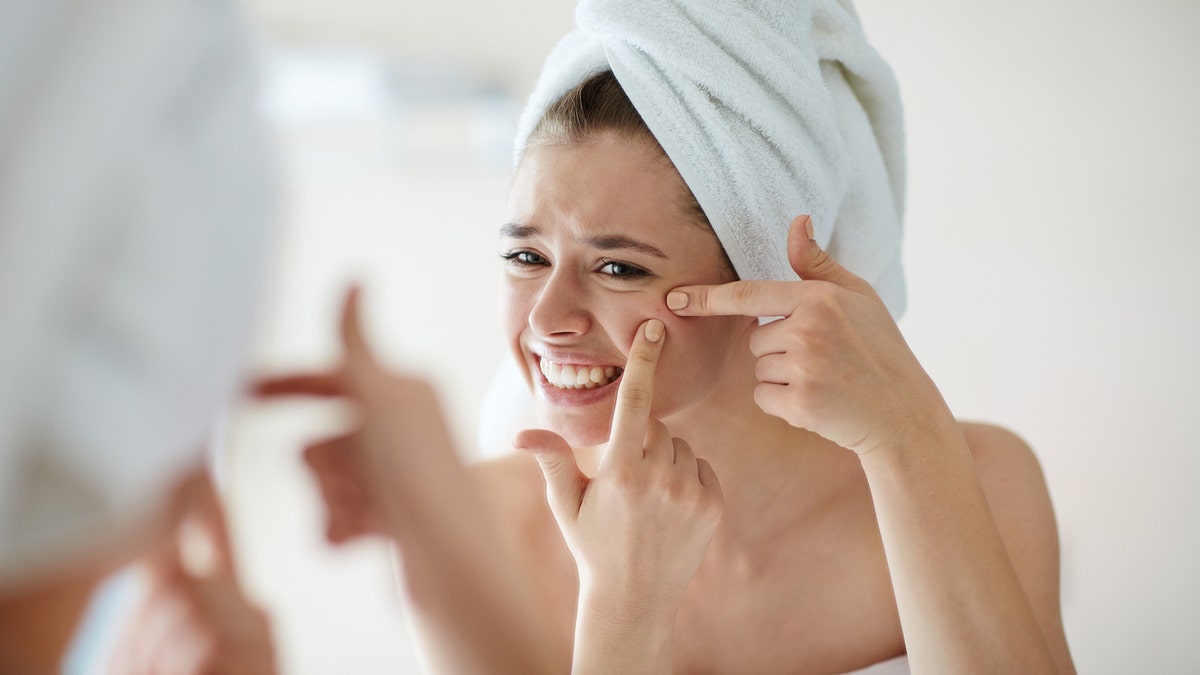
Displeased young woman squeezing pimples in front of mirror (iStock)
Have you ever slapped a strip on your nose in hopes of sucking out all the gunk clogging your pores, only to be thoroughly disappointed once you pull it off and realize that there’s barely anything on the strip? Come on, you know EXACTLY what we’re talking about. So let us introduce a novel concept — maybe, just maybe, those aren’t blackheads after all. Perhaps the reason you aren’t vacuuming out trapped oil, dirt, and debris one pore strip at a time is simply because there’s nothing to vacuum out in the first place.
Wait, what?
Related: 10 Things You Own That You Need to Clean Immediately
It’s true. The gray or blackish speckles that dot your nose aren’t necessarily blackheads. They could be sebaceous filaments, which, unlike blackheads, don’t consist of the same oh-so-squeezable gunk. “Blackheads develop when a clog or plug forms in the opening of hair follicles in your skin,” notes David J. Goldberg, a board certified dermatologist and the Director of Skin Laser & Surgery Specialists of New York and New Jersey. To break it down, every single hair follicle on your body contains a hair and a sebaceous gland that produces sebum (AKA oil in derm-speak). From an evolutionary standpoint, oils were meant to keep skin soft and hydrated before manmade moisturizers came along, but your body’s natural oils can become problematic if your oil production center starts operating in overdrive. “As dead skin cells and oils build up in the opening to the skin follicle, then oxidize and turn dark, blackheads start to form,” Dr. Goldberg clarifies.
More From Teen Vogue
Then what the heck is a sebaceous filament? Nothing you should be worrying about, and definitely not squeezing, though their presence on your nose will likely be a permanent source of irritation to you. “A sebaceous filament is a naturally occurring part of your skin’s system designed to bring oil to the skin,” Dr. Goldberg says.
Sebaceous glands are scattered throughout the body, but they’re highly concentrated around your nose and forehead, which is why sebaceous filaments crop up in these areas, notes Ava Shamban, a board certified dermatologist and author of Heal Your Skin: The Breakthrough Plan for Renewal. Blackheads, on the other hand, pop up randomly on your face, are often larger in size and tend to be slightly raised — whereas sebaceous filaments are flat, and you can't be more than half an inch from your mirror to even see them.
Like blackheads, sebaceous filaments live in the actual pore, but when you squeeze them, you won’t see the same white “string cheese” that slinks out of a blackhead, Dr. Ava says. “Sebaceous filaments are a normal part of skin function,” Dr. Goldberg says, so please leave them alone and avoid magnifying mirrors that tempt you to squeeze (we’re begging!). “If your skin is well cared for, they won’t cause any sort of issue.”
Meanwhile, blackheads should be removed so you can keep your pores clear — otherwise they’ll continue to grow larger in size — but only by a professional who is well versed in extraction methods. “Many people try to extract their own blackheads by squeezing them, but that can cause great damage to the skin,” Dr. Goldberg says. “Since blackheads are made of hardened oil and cell debris, they can require a lot of pressure to remove.” Pros typically use steam and a detoxifying mask to help to loosen blackheads and prep them for extraction without causing damage to the skin, he adds.
Though preventing your pores from clogging in the first place is key, luckily, it’s possible to dissolve blackheads on your own at home. All you need is a healthy dose of patience and a steady serving of BHA’s, which are a type of chemical exfoliator (as opposed to a manual exfoliator like your Clarisonic cleansing device, or a scrub with little particles in it). BHA’s are ideal for treating blackheads because instead of just loosening debris trapped deep within your pores, they actively penetrate them to remove whatever’s in there. Salicylic acid is one of the most recognizable and commonly used BHA’s. “Salicylic acid products that keep the skin clear of cell build-up and debris can help pores stay clear,” Dr. Goldberg says. He personally recommends using PCA Skin Acne Gel as a spot treatment to combat existing blackheads, or using it as a full-face treatment as a prevention method. Biore Warming Anti-Blackhead Cleanser, which is formulated with a special kind of clay that heats up to help loosen clogs, is another great option but comes with a cheaper price tag. Also, try working chemical peel pads with sal acid into your skincare routine. Start by using them once or twice a week to see how your skin reacts, then slowly bump it up to three times per week. “Regular superficial chemical peels also help to detoxify and remove impurities, which prevents blackheads” We love M-61 PowerGlow Peels because they’re packed with sal acid, but also contain chamomile to soothe skin.
Now you know.
